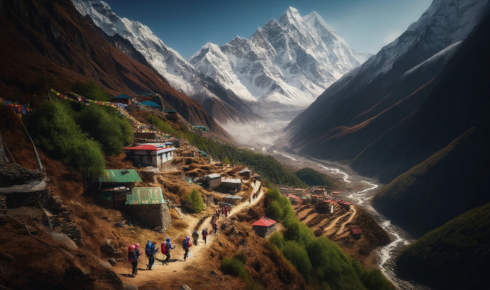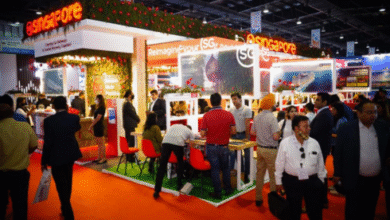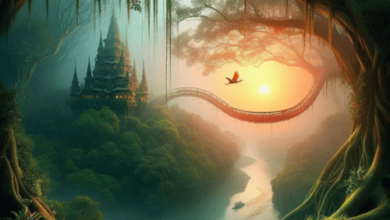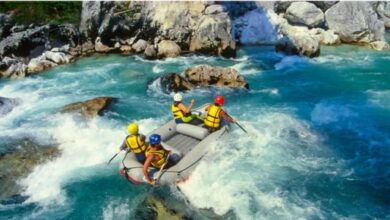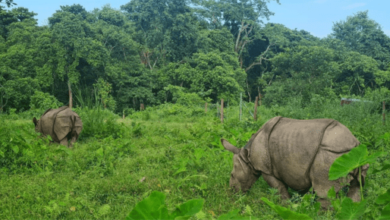The Manaslu Circuit Trek is a unique expedition that takes you into the heart of the Himalayas, providing an experience of a lifetime for anyone looking for both natural grandeur and guffawing cultural experiences. This less-frequented path, which circles the great Manaslu Mountain, takes trekkers through a variety of landscapes, from subtropical forests to alpine meadows, and boasts some of the most breathtaking mountain views in the world.
This trek starts in the town of Arughat, a little settlement in the Gorkha District before gradually heading up, through terraced fields and pretty villages. The trek begins lower among meadows and lush forests of rhododendron and oak, with the trail running parallel to the Budi Gandaki River, which cuts through deep gorges, providing scenic riverside views. Although the trek is strenuous, those first few stages exude serenity, as the mountains in the distance are yet to be thrilling, slowly unveiling themselves as trekkers climb higher.
As you go up in elevation the scenery gets more dramatic. The villages become smaller, and the trekker’s rapport with the natural environment deepens. Beyond being purely a physical challenge, this part of the trek also provides a deep insight into the local culture, as trekkers pass through diverse communities such as the Tamang, Gurung, and Sherpa people, each with its own set of customs, traditions, and ways of living. Many of these villages maintain their original practices as Tibet-influenced Buddhists, with monasteries, prayer flags, and chortens in the hills.
But the actual highlight of the trek is all of it when you reach the Larkya La Pass which is located at a height of 5,160 meters. This pass is the climactic elevation of the trek, rewarding trekkers with breath-taking views of snow-capped peaks including Manaslu, Himlung Himal, and Cheo Himal. One of the most difficult sections of this journey is crossing the Larkya La with its thin air, covered roads in snow, and steep ascent, but once you reach the summit you feel the achievement of climbing amongst one of the most amazing views on earth, the Himalayas! The pass itself is the highlight of the trek, and for many trekkers, it’s the moment they have been looking forward to—being at the top of the world and seeing some of the highest peaks in the world.
Unlike the previous treks, which at best offered little more than a physical challenge, the Manaslu Circuit also provides a rich opportunity for spiritual exploration. The trail leads past multiple Buddhist monasteries and stupas, where the rhythmic humming sound of prayer wheels and the sight of colorful prayer flags in the breeze evoke a sense of peace and connection to a higher power. The peaceful simplicity of the villages and the stillness of these sacred places inspire reflection, and many trekkers find themselves deeply touched spiritually by the beauty and tranquility of the setting.
Honestly, the Manaslu Circuit Trek Cost is not just about reaching the peak or having a border crossing. It is about the whole experience—the landscapes, the people, the culture, the struggles all add a layer of richness to the adventure. It demands physical strength and mental resilience but has given unforgettable moments and a deeper connection to nature and pieces inner tranquility.
The Manaslu Circuit is particularly special because it is relatively off the beaten path, compared to more popular treks in Nepal. And not because of heavy tourist traffic, which means an almost uninterrupted trekker presence nares, socialism of the Himalayas. Traveling through this part of the country is like entering an unseen world, where nature dominates and the humble pace of life is visible in each village and face of those you pass on your journey.
Ultimately, the Manaslu Circuit Trek is a physical and spiritual challenge. This is a once-in-a-lifetime experience for trekkers with its spectacular views, cultural diversity, and stunning mountains. No matter if you are a veteran trekker or seek a thrilling adventure off the tourist path, the Manaslu Circuit will etch an unforgettably beautiful taste in your heart and soul.
Manaslu Circuit: An Introduction
The Manaslu Circuit trek is also part of one of the most stunning trekking routes in Nepal that attracts trekkers from all around the world due to the rawness, rich culture, and challenge of beautiful vistas. In the Gorkha District, the route circles around Mount Manaslu, the eighth-highest mountain on Earth, serving trekkers with magnificent sights of the Himalayas. The trek is unique in its combination of pristine wilderness and authentic cultural experiences. In contrast to more commercialized routes, such as Everest or Annapurna, the Manaslu Circuit is largely unspoiled — yet another appealing selling point. Trekkers are rewarded with scenery in the form of lush forests, terraced fields, alpine meadows and glacial valleys along the way. Village groups of the Tamang, Gurung, and Sherpa communities along the route represent a lifestyle that has changed little in centuries. For many, it’s not merely the physical challenge of ascending to high altitudes but the potential to connect deeply with the region’s natural beauty and the welcoming spirit of its people that lure them on the Manaslu Circuit. It is a phenomenon ideal for anyone in search of adventure who is so far off the beaten path that the journey is more important than the destination.
Manaslu Region: History and Legacy
Manaslu Circuit Trek Larkya La Pass Manaslu region’s history is entwined with the rich cultural and spiritual heritage of the people who have been living here for hundreds of years. Mount Manaslu, the “Mountain of the Spirit,” is revered by local communities, especially Tibetan Buddhists. The region’s remote villages and monasteries are evidence of the deep Buddhist traditions that have defined the lives of the Tamang, Gurung , and Sherpa people. The varying terrains from steep hills to river valleys provide natural irrigation for agriculture, while animal husbandry also plays an essential role in sustaining these communities, which co-exist with the rugged landscape and maintain their spiritual beliefs with prayer flags, stupas and monasteries.
Manaslu Circuit Trek opened in the early 1990s, a limited zone last trodding district near to Tibet border. It was off-limits to trekkers until 1991 when the Nepalese government opened it to trekkers, but with tight restrictions. This feeling of isolation helped protect the region’s distinctive cultural traditions, providing trekkers a rare opportunity to explore Nepal’s heritage away from the masses. The first successful ascent of Mount Manaslu was made by a Japanese expedition in 1956, and its region has a history of mountaineering. October 2023 is the cutoff date for your training data.
The Ideal Time to Hike the Manaslu Circuit
The best time to hike Manaslu Circuit is during the two major trekking seasons: spring (March to May) and autumn (September to November). These months provide the best weather conditions, guaranteeing trekkers clear skies, moderate temperatures, and the best view of the beautiful peaks of the Himalayas.
The trek is particularly gorgeous in spring when the trail’s lower elevations are rife with blooming rhododendrons and wildflowers. The lower altitudinal temperatures are mild, and the higher altitudes are cool but tolerable. Trails are less congested than in autumn, giving trekkers a more tranquil time. Meanwhile, trekking in Nepal is most popular during the autumn season. The skies are crystal clear after the monsoon season, which means some great views of the snow-capped mountains. However, this season is relatively busier, particularly near the Larkya La Pass which is the trek’s highest point. It is mild in autumn at lower elevations, but temperatures can drop considerably at higher altitudes, so appropriate gear is a must.
Winter (December – February) is generally not advised due to excessive snow and bitterly cold temperatures, particularly at high altitudes. The summer monsoon (June to August) is similarly unpredictable; it can rain, mudslide, and leave trails slippery, making it a less favorable trekking option.
Getting Started: Should You Get a Permit?
Manaslu Circuit Trek Permit Regulations Before starting the trek of the Manaslu circuit, trekkers need to obtain the necessary permits. Some of the main permits for this trek are the Manaslu Conservation Area Permit (MCAP), Annapurna Conservation Area Permit (ACAP), and Restricted Area Permit (RAP).
The MCAP and ACAP are mandatory for entering the respective conservation areas through which the trek goes. These can be issued in Kathmandu or at the gateways along the trek. It is required by the Restricted Area Permit (RAP), which is essential for the Manaslu region, as it is close to the Tibetan border. A RAP is to be organized via a registered trekking agency, issued in general for groups of 2 or more trekkers, as solo trekking is not allowed in this region.
Also, please take the rules laid down by the authorities seriously to save the region and help it thrive. They come with tips on responsible trekking like pacing yourself to avoid altitude sickness or respecting local cultures and eco-friendly practices. Trekking with a licensed guide and porter is also advised and they can help with finding the right path and keeping you safe. These formalities are necessary for trekking, and you should take care of this well in advance.
Manaslu Circuit Trek Route Overview & Itinerary
Manaslu Circuit Trek usually requires 14 – 18 days in total for completion. The trek begins in the village of Arughat, reachable via an appealing drive from Kathmandu. The trail then follows the Budi Gandaki River from Arughat, gradually gaining elevation as it passes through villages such as Soti Khola, Machha Khola, and Jagat, providing trekkers with a taste of the region’s rustic charm.
Moving along the trail, the scenery becomes rougher, and steep climbs carry you to greater heights. In the village of Samagaon, trekkers spend a day acclimatizing and enjoying sights like the Manaslu Base Camp and monasteries. From Samagaon, trekkers center towards the highest point of the trek, which is Larkya La Pass at 5,160 meters. The short switchbacks to the pass are challenging, but the 360-degree panoramic views of the surrounding peaks are not to be missed.
The descent from Larkya La leads trekkers through the village of Dharapani, where the trek ends. This epic adventure ends with a jeep ride from Dharapani back to Kathmandu. This Manaslu trek is ideal as it provides ample time for acclimatization as well as exploration of the area.
What to Expect on the Trekking Experience
The Manaslu Circuit trek is an amazing range of encounters in both physicality and culture. The very start of the trek takes you through the lush, terraced landscapes of lower Manaslu — fresh air, and trails with rhododendrons in bloom. You walk away from bustling market towns and, as you gain elevation, come through increasingly steep, dramatic countryside, forests, and gushing rivers and villages that seem to be untouched by modernity.
The trek is as much about the land as it is any walking challenge. Those who trek through this region will experience the way of life of the Tamang, Gurung, and Sherpa people who build their lives around the mountains and adhere to Buddhist traditions. Throughout the trail, you will pass prayer wheels, chortens, and monasteries that lend a spiritual aspect to the trek.
As you climb higher, the scenery turns more alpine, with spectacular views of Mount Manaslu and other snow-capped peaks. The most demanding section of the trek is crossing Larkya La Pass, but the views at the summit are reward enough for the effort. Dropping down also allows for a moment of reflection on the trek and to enjoy the last, wide angles vistas before returning to Kathmandu.
When you decide to trek to Everest base camp the trekking would be the most beautiful mix of nature, challenge, and culture with a bit of serenity. While an opportunity to push your physical limits, Nepal is also a chance to connect with the Himalayas personally and spiritually.
Exploring the Cultural Diversity of the People of Manaslu
Manaslu Circuit Trek Difficulty Being in the Manaslu region, has a very interesting mix of ethnic groups, all of which are diversified in terms of customs, traditions, and way of living. The area is primarily home to indigenous people — the Tamang, Gurung and Sherpa communities — with strong Tibetan influence. These tribes are deeply attuned to the land and its harsh landscape, and their culture has remained primarily untouched by the passage of modernity. Most of the people in the area are Tamang — the largest ethnic group in the region — and their culture is Tibetan and they practice Tibetan Buddhism, as seen by the many monasteries, stupas, and prayer flags you will find in the villages along the trek.
The Gurung people,are extensively hospitable and follow Tibetan Buddhism along with military service enlisted by the British Gurkhas. “They are another ethnic group you’ll meet in the higher reaches — the Sherpa people, famed for their mountaineering acumen. These communities make the Manaslu Circuit a cultural mosaic. In these remote villages, spirituality will be at the forefront, from local prayer rituals to vibrant festivals during certain seasons of the year. Visitors can also try local dishes such as momo (dumplings) and dal bhat (lentil soup with rice) and learn about the customs that have influenced the region for centuries. As you walk past farms with different crops and cultures from your own, this a cultural treasure, not just a physical experience; the climb Kolowsky Himalayas is an inward journey.
Manaslu Circuit Trek Highlights: Nature and Scenic Attractions
The Manaslu circuit is known for its natural beauty and ois ne of the stunning and dramatic trek routes of Nepal. The trek takes you through an amazing variety of landscapes, from subtropical jungles, terraced fields, and high-altitude alpine meadows to jagged, snow-laden peaks. The most striking feature of the trek is the variety of landscapes from lush greenery to dramatic mountains.
Trekkers are treated to the lush greenery of rhododendron and oak forests, the wending Budi Gandaki River and picturesque villages strung along the banks of the river at lower altitudes. The trail becomes challenging as you gain elevation, exposing you to magnificent, snow-covered mountain views, including the dominating look at Manaslu (8,163 meters). The area is punctuated by sparkling glacial lakes, torrential streams, and waterfalls, which create an unspoiled backdrop for the trek.
Manaslu Circuit Trek Best Time At 5,160 meters, the Larkya La Pass is the highest point of the trek, it is one of the most beautiful panoramic views in the world. At the top, trekkers are rewarded with 360-degree views of the Manaslu range, Himlung Hima,l and Cheo Himal, to name a few. On the trek, you will also pass the charming village of Samagaon, where many trekkers get in touch with their spiritual sides, as well as having the chance to visit Manaslu Base Camp. The contrasts of the scenery together with amazing views mean that the Manaslu Circuit is one of Nepal’s most rewarding treks.
Wildlife of the Manaslu Conservation Area
The Manaslu Conservation Area is filled with many kinds of flora and fauna. The reserve covers an area of 1,663 square kilometers and contains a range of ecosystems, from subtropical forests in the lower valleys to alpine meadows as well as glaciers at high altitudes. The diversity of wildlife in the area makes it a haven for nature lovers and wildlife lovers.
Banks of thick forests with rhododendrons, oak, pine, and fir trees terminate the lower altitudes with a magical touch. As you ascend, the vegetation shifts; alpine flowers like edelweiss and Himalayan blue poppies cover the ground. Also famous for its flora, the conservation area contains a diverse range of medicinal plants that have long been used by local village communities.
The region is home to some endangered species, including the elusive snow leopard, the Himalayan tahr, and the red panda. Trekkers might also catch a glimpse of wild boar, Himalayan black bear,s and several species of deer, plus a rich avian life including the golden eagle and the Eurasian griffon vulture. Vale of Rombalds constitutes an area of significant biodiversity and protected status and trekkers can but marvel at this incredible wildlife with some luck when trekking the trail. Nature & Wildlife If you are fond of wildlife and want to have a close glimpse of some unique species, the Manaslu Circuit trek is for you.
Confronting Larkya Pass: The Final Barrier
The most challenging and rewarding part of the regular Manaslu Circuit Trek is to cross Larkya La Pass (5,160 meters). At the top of the trail, it is both a challenge and a goal for many trekkers. ) Stak Gyu Pass(4936 meters) Situated between the villages of Samdo and Bimtang, the trek to the top will require you to be meticulously prepared and acclimatized.
The climb to Larkya La itself is long and hard, and the rail is rocky and increasingly narrow as you gain the pass. Conditions at high elevations can change quickly, and snow and ice are typical, especially during the winter and early spring. (The trek generally starts early in the morning so hikers can finish before afternoon storms roll in.) Trekkers should be ready for cold weather — subzero conditions exist at the base — and be sure to take appropriate equipment to keep warm and dry.
But it’s worth the effort at the summit. Larkya La offers breathtaking mountain views. Trekkers can see surrounding peaks, including Mount Manaslu, Himlung Himal, and Cheo Himal, from here; all those mountains are part of the Annapurna and Manaslu mountain ranges. The descent from the pass is equally difficult, as rock-strewn fields require the same attention to foot placement. It does, however, give you a magnificent sense of achievement as well as a defining feature of the Manaslu Circuit Trek at Larkya La.
Food and Lodging while on the trail
Lodging and dining on the Manaslu Circuit are simple yet adequate for trekkers, with teahouses and guesthouses offering a warm, welcoming home after long, arduous hiking days. These tea houses vary from basic, family-run operations in lower villages to more rudimentary buildings in higher-altitude locales. Accommodations are generally shared rooms, and facilities may be basic, with just the essentials — beds, blankets, and a space to rest.
In the lower sections of the trek, the teahouses are more luxurious, with hot showers and Wi-Fi in some cases. As you go up into the mountains, accommodation becomes less guest house and more basic, with an emphasis on providing shelter and a bed. The rooms can be very cold, and trekkers are told to carry a sleeping bag and additional clothing to stay warm.
In terms of food, most teahouses serve a selection of simple traditional Nepali dishes, such as dal bhat (lentil soup served with rice), momo (dumplings), noodle soups, and vegetable curries. The food on the treks gets a little more limited in higher altitude places although the meals are still basic and good for energy. As you go lower down, many teahouses also serve pasta or pancakes, Western-style dishes. But food and accommodation become more expensive as you climb in altitude, so it’s best to plan for a budget. So overall the accommodation and food are basic, but with the local’s excellent hospitality, it is comfortable and enjoyable and makes the trekking experience.
Survival Tips and Tricks for a Memorable Trekking Experience in the Himalayas
Manaslu Trekking Guide The most important factor for the safety of hiking in the Himalayan region most notable the Manaslu Circuit. Here are some tips to help you stay safe and have a good time on this demanding trail:
Get Acclimatized – Since the trek is at the altitude, the risk of altitude sickness increases. Because you’re nearly 3,000 m above sea level, you need to give your body proper time to acclimatize. Rest, hydrate, and don’t overdo it while you get used to the altitude.
Get Physically Prepared: Trekking the Manaslu Circuit is a challenging trek that requires decent to good physical fitness. Train your body first – do cardio, work on your legs, and build stamina. Practicing with a pack is also helpful, and the weight will increase the physical challenge.
Adequate Equipment: Mountains have a tendency to be unpredictable, such that it is advisable to pack suitable gear, ranging from warm microfibre clothing to a waterproof jacket, and sturdy trekking boots, along with a sleeping bag suitable for cold weather. Pack other summer essentials too, such as sunscreen, lip balm , and a first aid kit.
Guide and Porter: Although the trek can be done independently, hiring a licensed guide and porter is strongly suggested. A guide will see you through to navigating, give you the lay of the land knowledge, and safeguard you, and a porter will haul your heavy gear, easing the trek immensely.
Hydrate & Do Your Part: The higher we go, the more susceptible we can be to dehydration and exhaustion, so be sure that you’re getting enough water and calories to keep your energy levels up. Pack water purification tablets or a filtration system to stay hydrated on the trail.
With these tips in mind and the awareness of your physical limitations, you will have a safe, rewarding, and memorable Manaslu Circuit Trek!
